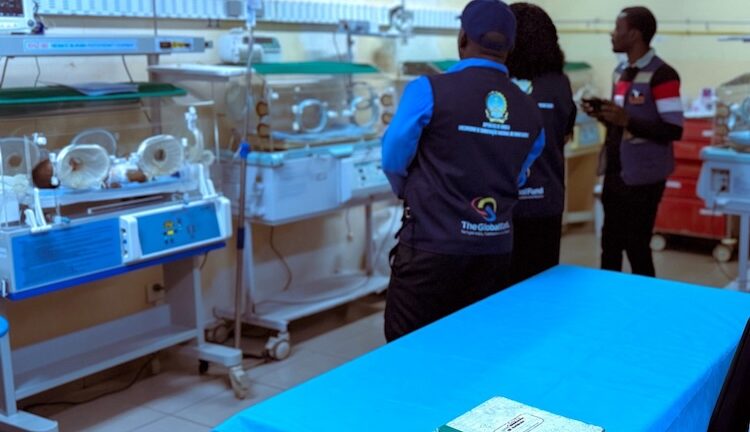By Praise Nutakor
The writer is a Partnerships and Communications Specialist at UNDP.
NEW YORK | 2 November 2025 (IDN) — Every breath matters. For a newborn struggling for air, an expectant mother requiring surgery, or a patient battling respiratory illness, access to medical oxygen can mean the difference between life and death. Yet in many hospitals, life-saving oxygen remains in short supply.
“To be honest, I don’t know if we would be having our son today. He might have passed on. By the time we reached the hospital, he was struggling to breathe. His eyes were rolling. He wasn’t responding,” recounted Sarah at Al Sabbah Children Hospital in Juba, South Sudan.
Filling the Oxygen Supply Gap
An estimated 60 per cent of the world’s population lacks access to safe and affordable medical oxygen. In low- and middle-income countries, nine out of ten hospitals lacked the equipment to provide oxygen therapy, resulting in 800,000 preventable deaths per year even before the COVID-19 pandemic.
“At the onset of the COVID-19 pandemic in March 2020, none of The Gambia’s public hospitals had access to medical oxygen, and the country was relying on imports from Senegal and a local supplier, Banjul Oxygen,” recalled Aissata De, Deputy Director of UNDP’s Regional Bureau for Africa, who was then UNDP Resident Representative in The Gambia.
“We had to mobilise partners to bridge this critical gap to save lives,” she added.
A similar situation occurred in South Sudan, which relied on its neighbouring country, Uganda, for additional supplies. Deliveries were occasionally delayed and costly due to transportation expenses.
Beyond the pandemic, medical oxygen remains vital for everyday healthcare, from powering intensive care units and surgical theatres to saving mothers and children.
“There was one bed left with an oxygen tank, and my son, who was diagnosed with severe pneumonia, was immediately put on oxygen. Then, his breathing stabilised, his oxygen levels went up,” added Sarah.
Building Sustainable Oxygen Infrastructure
Sarah’s story is a stark reminder of the stakes and underscores the need for sustained investment and partnerships to bridge the oxygen supply gap.
Thanks to support from the Global Fund to Fight AIDS, Tuberculosis, and Malaria, and its partners, including the United Nations Development Programme (UNDP), the World Bank, the World Health Organisation (WHO), and national governments, countries in Africa, Asia, and beyond are closing the oxygen supply gap. The initiative is part of broader efforts to strengthen the ability of national health systems to deliver life-saving care reliably.
In South Sudan, two high-capacity oxygen plants were installed at the Wau Regional Warehouse and Riverside Warehouse in Gumbo, jointly operated by the Ministry of Health and UNDP. Together, they produce around 1,000 litres of oxygen daily, supplying hospitals like Al Sabbah Children’s Hospital in Juba. UNDP also supported the installation of an oxygen piping system at Juba Teaching Hospital, providing a safe and consistent supply at the country’s central referral facility.
Dr Angelo Omawo, Medical Director at Al Sabbah Children’s Hospital, emphasised the importance of oxygen supply. “We receive referrals from all 10 states. Our Outpatient Department (OPD) sees 300–500 patients daily. Of these, around 50 are admitted, and at least ten require oxygen, mostly for severe malaria, pneumonia, congenital heart disease, and respiratory conditions.”
She added, “Before the Global Fund partnership installed the oxygen plants, we had to buy oxygen. It was expensive, and the hospital couldn’t afford it.”
In Angola, with funding from the Global Fund, UNDP partnered with the Ministry of Health to install medical gas piping systems that supply oxygen directly to patients at their bedsides. Pressure Swing Adsorption (PSA) oxygen plants in eleven major hospitals across the country enable the transition to sustainable on-site production, securing a reliable supply and reducing reliance on external providers.
In The Gambia, the installation of an oxygen generator at Edward Francis Small Teaching Hospital- Bakau (Ndemban) has transformed healthcare delivery in the country. The facility now produces its own oxygen, ensuring a consistent and reliable supply for patients, thanks to a partnership among the UNDP, the World Bank, and the WHO.
The Global Fund contributed to nationwide coverage. This advancement has strengthened the health system’s capacity, reduced dependence on imports, and brought life-saving care closer to those who need it most.
“This is one of the milestone achievements of the health sector in The Gambia since independence. Having an oxygen plant in-country is greatly alleviating the suffering of patients and reducing mortality,” noted The Gambia’s Minister of Health, Dr Ahmadou Lamin Samateh.
Global Impact, Local Change
To date, the UNDP has deployed over 116 PSA oxygen plants across Africa and Asia, thereby strengthening access to quality-assured medical oxygen in 67 hospitals, including those in Afghanistan, Djibouti, Pakistan, Kyrgyzstan, São Tomé and Príncipe, and Sudan.
These facilities are significantly enhancing the availability of medical oxygen for emergencies and critical care, thereby improving national preparedness for respiratory diseases and future pandemics.
Looking Ahead
As the largest funder of medical oxygen in low- and middle-income countries, the Global Fund’s investments go beyond machines and pipelines. It is about saving lives, building resilience, and ensuring no patient is left gasping for air. With continued investment, we can strengthen health systems and build a future where oxygen is available to all who need it. [IDN-InDepthNews]
Image: In Angola, medical gas piping systems provided with the support of the Global Fund and partners at Kilamba Kiaxi Municipal Hospital are supplying life-saving oxygen to newborns and patients. From rural clinics to national hospitals, Global Fund-supported oxygen plants provide a lifeline and strengthen health resilience.

